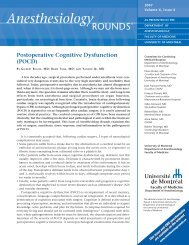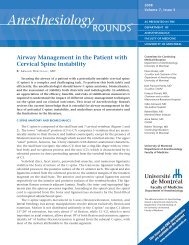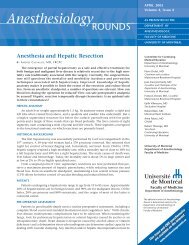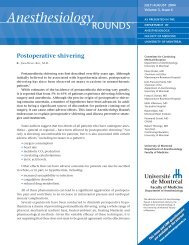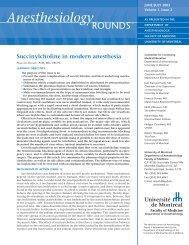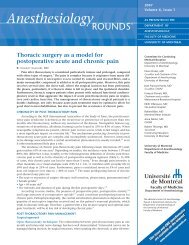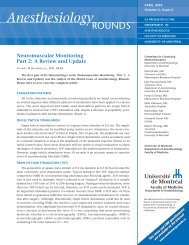The epidural test dose in obstetric anesthesia - Anesthesiology ...
The epidural test dose in obstetric anesthesia - Anesthesiology ...
The epidural test dose in obstetric anesthesia - Anesthesiology ...
You also want an ePaper? Increase the reach of your titles
YUMPU automatically turns print PDFs into web optimized ePapers that Google loves.
<strong>Anesthesiology</strong>ROUNDSMAY 2003Volume 2, Issue 5AS PRESENTED IN THEDEPARTMENT OFANESTHESIOLOGY,FACULTY OF MEDICINEUNIVERSITY OF MONTREAL<strong>The</strong> <strong>epidural</strong> <strong>test</strong> <strong>dose</strong> <strong>in</strong> <strong>obstetric</strong> <strong>anesthesia</strong>NICOLE LESSARD MD, FRCPCComplications related to <strong>anesthesia</strong> represent the 6 th lead<strong>in</strong>g cause of pregnancy-relatedmortality. In 82% of cases, death occurs dur<strong>in</strong>g a caesarean section.Often, it is a situation where elective procedures are adm<strong>in</strong>istered to young femalepatients whose death could have been prevented by experienced personnel.Accord<strong>in</strong>g to Hawk<strong>in</strong>s, 1 the maternal mortality rate related to <strong>anesthesia</strong> decl<strong>in</strong>edfrom 4.3 (1979-81) to 1.7 (1988-90) per million live births. This drop <strong>in</strong> mortality isattributed to the <strong>in</strong>creased use of regional <strong>in</strong>stead of general <strong>anesthesia</strong>. Closerattention to the toxicity of local anesthetics and the adoption of measures such asuse of the <strong>test</strong> <strong>dose</strong> and the cont<strong>in</strong>uous rather than bolus adm<strong>in</strong>istration of localanesthetic solutions at low concentrations have contributed to the reduction <strong>in</strong>mortality. S<strong>in</strong>ce <strong>test</strong> <strong>dose</strong>s came <strong>in</strong>to use 20 years ago, they have been one of themost controversial issues <strong>in</strong> <strong>obstetric</strong> <strong>anesthesia</strong>. As def<strong>in</strong>ed by Moore and Batra <strong>in</strong>1981, a <strong>test</strong> <strong>dose</strong> is the <strong>in</strong>jection <strong>in</strong> an <strong>epidural</strong> catheter of 15 µg of adrenal<strong>in</strong>ecomb<strong>in</strong>ed with 3 ml of local anesthetic. <strong>The</strong> objective is to detect tachycardiawith<strong>in</strong> 60 seconds, a sign of an accidental <strong>in</strong>travenous (IV) <strong>in</strong>jection, therebyavoid<strong>in</strong>g <strong>in</strong>jection of a massive toxic <strong>dose</strong> of local anesthetic. 2Is the <strong>test</strong> <strong>dose</strong> still useful? Should it be redef<strong>in</strong>ed? Is there one ideal <strong>test</strong> <strong>dose</strong>?Should we abandon it as some authors have recommended? It must not be forgottenthat, despite a decl<strong>in</strong>e <strong>in</strong> the <strong>in</strong>cidence of fatal systemic complications relatedto the IV <strong>in</strong>jection of local anesthetics, this danger lurks <strong>in</strong> our practice every day.BACKGROUNDIn 1979, Albright reported 5 cases of circulatory collapse follow<strong>in</strong>g accidental IVadm<strong>in</strong>istration of bupivaca<strong>in</strong>e to pregnant women, and 1 case follow<strong>in</strong>g the adm<strong>in</strong>istrationof etidoca<strong>in</strong>e dur<strong>in</strong>g <strong>epidural</strong> regional <strong>anesthesia</strong>. In each case, aspiration prior tothe <strong>in</strong>jection was negative for blood return. Fibrillation or ventricular tachycardia, asystoliaor complete block occurred quickly, mak<strong>in</strong>g resuscitation difficult. 3 In 1981, <strong>in</strong> astudy of 175 patients, Moore and Batra found that 15 µg of adrenal<strong>in</strong>e <strong>in</strong>creases theheart rate from 79 ± 14 to 111 ± 15 beats per m<strong>in</strong>ute <strong>in</strong> 23 ± 6 seconds, with a return tobasel<strong>in</strong>e with<strong>in</strong> 32 ± 33 seconds. 2 With this study, and Albright’s recommendation <strong>in</strong>1984, the <strong>test</strong> <strong>dose</strong> became rout<strong>in</strong>e practice for <strong>in</strong>itiat<strong>in</strong>g <strong>epidural</strong> <strong>anesthesia</strong>. 4In 1990, Gu<strong>in</strong>ard et al confirmed Moore and Batra’s f<strong>in</strong>d<strong>in</strong>gs and def<strong>in</strong>ed a positive<strong>test</strong> <strong>dose</strong> as an <strong>in</strong>crease <strong>in</strong> heart rate of ≥ 20 beats per m<strong>in</strong>ute follow<strong>in</strong>g <strong>in</strong>jection of10 to 15 µg of adrenal<strong>in</strong>e, comb<strong>in</strong>ed with 3 ml of 1% lidoca<strong>in</strong>e. However, these dataapplied only to young, healthy, nonpregnant, unpremedicated subjects who were nottak<strong>in</strong>g beta-blockers. 5RISKS ASSOCIATED WITH AN EPIDURAL BLOCK<strong>The</strong> risks <strong>in</strong>volved dur<strong>in</strong>g the <strong>epidural</strong> <strong>in</strong>jection of a local anesthetic <strong>in</strong>clude:• accidental subdural <strong>in</strong>jection• subarachnoid <strong>in</strong>jection• <strong>in</strong>travenous <strong>in</strong>jectionCommittee for Cont<strong>in</strong>u<strong>in</strong>gMedical EducationDepartment of <strong>Anesthesiology</strong>University of MontrealPierre Drolet, MDChairman and EditorMaisonneuve-Rosemont HospitalJean-François Hardy, MDChairman of theDepartment of <strong>Anesthesiology</strong>,University of MontrealFrançois Donati, MDMaisonneuve-Rosemont HospitalEdith Villeneuve, MDSte-Just<strong>in</strong>e HospitalRobert Bla<strong>in</strong>, MDMontreal Heart InstituteNormand Gravel, MDCHUMRobert Thivierge, MDVice-DeanCont<strong>in</strong>u<strong>in</strong>g EducationUniversity of MontrealUniversity of MontrealDepartment of <strong>Anesthesiology</strong>Faculty of Medic<strong>in</strong>eC.P. 6128, Succursale Centre-VilleMontréal (Québec) H3C 3J7Pavillon pr<strong>in</strong>cipal, bureau S-712Tel: (514) 343-6466Fax: (514) 343-6961E-mail: anesth@medcl<strong>in</strong>.umontreal.caFaculty of Medic<strong>in</strong>eDepartment of <strong>Anesthesiology</strong><strong>The</strong> editorial content of <strong>Anesthesiology</strong>Rounds is determ<strong>in</strong>ed solely by theDepartment of <strong>Anesthesiology</strong> ofthe University of Montreal Facultyof Medic<strong>in</strong>eThis This issue issue and and CME CME questionnairequestionnaireare are available available on on the the Internet Internetwww.anesthesiologyrounds.ca
plasmatic peak of <strong>in</strong>travenous fentanyl is immediateand occurs 5 to 10 m<strong>in</strong>utes after an<strong>epidural</strong> <strong>in</strong>jection. Unfortunately, Yoshii foundthat 92% of patients <strong>in</strong> labour <strong>in</strong>jected with100 µg of fentanyl, <strong>in</strong>travenously or <strong>in</strong> the<strong>epidural</strong> space, were unable to accurately identifythe way it was <strong>in</strong>jected, based on a descriptionof the symptoms. Some patients describedno symptoms dur<strong>in</strong>g an IV <strong>in</strong>jection ordescribed symptoms dur<strong>in</strong>g an <strong>epidural</strong> <strong>in</strong>jectionfor a 5% <strong>in</strong>cidence of false positives and95% specificity. 18 An IV <strong>in</strong>jection of fentanyl 60m<strong>in</strong>utes earlier or an <strong>in</strong>jection of fentanyl <strong>in</strong> the<strong>epidural</strong> space 90 m<strong>in</strong>utes earlier, did not appearto <strong>in</strong>terfere with the <strong>test</strong>. Yet, the fentanyl <strong>test</strong>has some disadvantages. If the result is dubious,do<strong>in</strong>g a second <strong>test</strong> is not desirable due to thesuperimposition of effects. In addition, fentanylcannot be used to detect an accidental subarachnoid<strong>in</strong>jection.IsoproterenolIsoproterenol is the most powerful of thenon-selective beta-adrenergic agonists. Comparedto alpha and beta agonists such as adrenal<strong>in</strong>e,it does not cause a biphasic heart rate orbradycardia, reflexes observed <strong>in</strong> response to thealpha-adrenergic effect. S<strong>in</strong>ce its cardiac effectsare only slightly altered by the presence of anestheticagents such as sevoflurane and isoflurane,many studies are try<strong>in</strong>g to demonstrate its effectivenessas a <strong>test</strong> <strong>dose</strong> for children or adultsunder general <strong>anesthesia</strong>. In pregnant women,the chronotropic effect of isoproterenol isdim<strong>in</strong>ished. 19 Moreover, no histopathologicaldocument has proven the <strong>in</strong>nocuousness ofisoproterenol <strong>in</strong>jected <strong>in</strong>to the subarachnoid or<strong>epidural</strong> spaces.Adrenal<strong>in</strong>e <strong>in</strong>jectionAdrenal<strong>in</strong>e <strong>in</strong>jection is a simple <strong>test</strong>. Itrequires little equipment, no cooperation fromthe patient, and monitor<strong>in</strong>g is easily accessible.Nevertheless, some restrictions and contra<strong>in</strong>dicationsshould be noted. General <strong>anesthesia</strong>,advanced age, and the use of beta-blockers attenuatethe response to adrenal<strong>in</strong>e. An <strong>in</strong>crease <strong>in</strong>oxygen consumption may cause myocardialischemia and cardiac arrhythmia. In pregnantwomen, reduced sensitivity to adrenal<strong>in</strong>e hasbeen clearly proven. Moreover, a few cl<strong>in</strong>icalsituations contra<strong>in</strong>dicate its use (Table 2).In a study of 20 female patients, Leightonand Norris reported fetal distress <strong>in</strong> 2 fetusesfollow<strong>in</strong>g the <strong>in</strong>jection of 15 µg of adrenal<strong>in</strong>e.TABLE 2: Contra<strong>in</strong>dications for adrenal<strong>in</strong>e withpregnant patients• High blood pressure• Preeclampsia• Cardiovascular disease• Tak<strong>in</strong>g beta-blockers• Tachycardia >125 bpm• Coca<strong>in</strong>e <strong>in</strong>toxication• Compromised uteroplacental perfusion• High uter<strong>in</strong>e contraction frequency (< 1 m<strong>in</strong>.)• Monitor<strong>in</strong>g impossibleOne showed late deceleration for 10 m<strong>in</strong>utesand the other, 4 m<strong>in</strong>utes of bradycardia followedby a decl<strong>in</strong>e <strong>in</strong> the variability of the fetal heartfor 7 m<strong>in</strong>utes. In both cases, cardiac variabilityreturned to basel<strong>in</strong>e after 20-25 m<strong>in</strong>utes. <strong>The</strong>APGAR scores at 5 m<strong>in</strong>utes were nonetheless≥7. 20 Although a normal and healthy fetus caneasily tolerate a reduction <strong>in</strong> uter<strong>in</strong>e flow, a fetus<strong>in</strong> distress may have a different response. Howcan the response be predicted? Both distressedfetuses were <strong>in</strong> good condition at the time of theadrenal<strong>in</strong>e <strong>in</strong>jection. In a pregnant sheep, not <strong>in</strong>labour, a 55%-65% reduction <strong>in</strong> uter<strong>in</strong>e flowfrom base value was observed after <strong>in</strong>jections of10 and 20 µg of adrenal<strong>in</strong>e. <strong>The</strong> reduced flowlasted for 3 m<strong>in</strong>utes. <strong>The</strong> fetal heartbeat, maternalarterial tension, and fetal and maternal arterialblood gases did not change. This reduction<strong>in</strong> uter<strong>in</strong>e flow is identical to what occurs dur<strong>in</strong>ga normal uter<strong>in</strong>e contraction. <strong>The</strong>refore, such areduction <strong>in</strong> uter<strong>in</strong>e flow due to an adrenal<strong>in</strong>e<strong>in</strong>jection superimposed on the effect of acontraction could compromise the <strong>in</strong>tegrity ofthe fetus. 21 In estimat<strong>in</strong>g placental perfusion bymeasur<strong>in</strong>g the velocity of umbilical cord flow witha Doppler, it was demonstrated that an <strong>in</strong>jectionof 8 ml of 1.5% lidoca<strong>in</strong>e with 1/200,000 adrenal<strong>in</strong>ecauses a greater decl<strong>in</strong>e <strong>in</strong> umbilical flow ifthe flow resistance is high at the onset. 22Adrenal<strong>in</strong>e <strong>test</strong> positivity criteria<strong>The</strong> <strong>test</strong> <strong>dose</strong> as def<strong>in</strong>ed by Moore and Batracannot be applied to pregnant women. <strong>The</strong> greatvariability <strong>in</strong> heart rate dur<strong>in</strong>g labour, along withthe reduced sensitivity to catecholam<strong>in</strong>es found<strong>in</strong> pregnant women, reduce <strong>test</strong>-<strong>dose</strong> specificity.In view of these facts, some authors modified thepositivity criteria for the <strong>test</strong>. In 1987, Leightonand Norris found only a 50% sensitivity to theadrenal<strong>in</strong>e <strong>test</strong> by us<strong>in</strong>g an <strong>in</strong>crease <strong>in</strong> heart rate≥ 25 bpm over the basel<strong>in</strong>e as positivity criteria. 20<strong>Anesthesiology</strong>ROUNDS
In 1992, Colonna-Romano observed that an<strong>in</strong>jection of 10 µg of adrenal<strong>in</strong>e is as effective as15 µg for identify<strong>in</strong>g an IV <strong>in</strong>jection. With an<strong>in</strong>crease <strong>in</strong> heart rate ≥ 10 bpm as the positivitycriteria, he demonstrated 100% sensitivity, but apositive predictive value of only 55%-73%. 23Later, the same author def<strong>in</strong>ed criteria for apositive adrenal<strong>in</strong>e <strong>test</strong> by compar<strong>in</strong>g the accelerationphase of tachycardia caused by adrenal<strong>in</strong>eto that caused by a uter<strong>in</strong>e contraction.S<strong>in</strong>ce the acceleration phase associated withadrenal<strong>in</strong>e is sharper than that stemm<strong>in</strong>g froma uter<strong>in</strong>e contraction, this makes it possible toidentify a positive <strong>test</strong> more accurately. 24 In1998, Colonna-Romano assessed all these criteria<strong>in</strong> a study <strong>in</strong>volv<strong>in</strong>g 198 pregnant patients.He looked for an <strong>in</strong>crease <strong>in</strong> heart rate to ≥10bpm over the basel<strong>in</strong>e observed one m<strong>in</strong>utebefore the <strong>in</strong>jection and for acceleration phase≥1.0 bpm. <strong>The</strong> <strong>test</strong> showed 100% sensitivity,96% specificity, a 100% negative predictivevalue, and a 63% positive predictive value.S<strong>in</strong>ce the prevalence of a positive <strong>test</strong> <strong>in</strong> thestudy was 12%, 4.5% of catheters were withdrawnneedlessly. 25<strong>The</strong>refore, the adrenal<strong>in</strong>e <strong>test</strong> is 100% sensitive,but lacks specificity. S<strong>in</strong>ce reposition<strong>in</strong>g acatheter is not risk-free (puncture of the duramater: 1%-2%; <strong>in</strong>travenous puncture: 7%-8%;block failure: 5%), some physicians are reconsider<strong>in</strong>gits use. Moreover, the concept of an accelerationphase is not easy to apply <strong>in</strong> practice.Currently, the adrenal<strong>in</strong>e <strong>test</strong> requires:• exclusion of some patients (see Table 2)• lower<strong>in</strong>g the threshold of the <strong>in</strong>crease <strong>in</strong>heart rate• monitor<strong>in</strong>g that is capable of detect<strong>in</strong>g arapid change <strong>in</strong> the heart rate• avoid<strong>in</strong>g an <strong>in</strong>jection dur<strong>in</strong>g a contractionIn view of these constra<strong>in</strong>ts, it may be justifiednot to consider adrenal<strong>in</strong>e as an acceptablealternative for detect<strong>in</strong>g an IV <strong>in</strong>jection. Furthermore,some authors emphasize the limitationsof a <strong>test</strong> <strong>dose</strong> with adrenal<strong>in</strong>e. For Norris, aspirationof multi-orifice catheters effectively detectsmost IV punctures (99.5% of cases). S<strong>in</strong>ce theprevalence of an IV catheter undetected by aspirationis low, a positive response to adrenal<strong>in</strong>edoes not necessarily mean an IV puncture. 26 Inpregnant women, the effects associated with the<strong>in</strong>jection or perfusion of a diluted mixed solutionof local anesthetic (bupivaca<strong>in</strong>e ≤ 0.125%)and narcotic are very likely to be limited toregression or failure of the block. Higher <strong>dose</strong>sare necessary to cause cardiac or central nervoussystem toxicity. When a block fails, removal ofthe catheter is recommended rather than <strong>in</strong>ject<strong>in</strong>ga bolus of a higher concentration. Birnbachand Chesnut believe the follow<strong>in</strong>g questionsshould be asked before abandon<strong>in</strong>g the adrenal<strong>in</strong>e<strong>test</strong>.• Is there an <strong>in</strong>fallible <strong>test</strong> <strong>dose</strong>?• Do changes <strong>in</strong> the practice of regional <strong>anesthesia</strong><strong>in</strong>volv<strong>in</strong>g the use of multi-orificecatheters and the slow perfusion of low concentrationsof local anesthetics justify abandon<strong>in</strong>gthe <strong>test</strong> <strong>dose</strong> with adrenal<strong>in</strong>e?• What do you do if a patient has to undergoan emergency caesarean when it is uncerta<strong>in</strong>that the catheter is properly placed? If thecatheter is not correctly positioned, the patientwill suffer longer before a decision is made toproceed with a new peridural technique.• Do anesthesiologists rema<strong>in</strong> at the bedsideof patients long enough to observe the responseto a therapeutic <strong>dose</strong> of local anesthetic?• Is the <strong>in</strong>convenience of replac<strong>in</strong>g a properlypositioned catheter follow<strong>in</strong>g a positive <strong>test</strong><strong>dose</strong> with adrenal<strong>in</strong>e greater than the morbidityor mortality associated with the accidental <strong>in</strong>jectionof a heavy <strong>dose</strong> of local anesthetic? 27It seems obvious that there is no perfect <strong>test</strong><strong>dose</strong>. Fentanyl, local anesthetics, and the air <strong>test</strong>have demonstrated only partial effectiveness fordetect<strong>in</strong>g an IV <strong>in</strong>jection. On the other hand,adrenal<strong>in</strong>e <strong>in</strong>jections have 100% sensitivity.Perhaps <strong>in</strong> some situations, the <strong>test</strong> <strong>dose</strong> withadrenal<strong>in</strong>e still represents the most suitable solution.Nevertheless, one must add observation,vigilance, and judgment. Paech, like Norris,argues that a <strong>test</strong> <strong>dose</strong> is always <strong>in</strong>dicated if theaspiration <strong>test</strong> is equivocal or questionable. 28CONCLUSIONIn conclusion, these are some recommendationsbased on the work by Norris: 10For <strong>in</strong>trathecal detection• Start with aspiration.• Test with 2.5 mg bupivaca<strong>in</strong>e; check for thesensation of heat, slightly altered sensibility,and mild motor block or rapid analgesia.Lidoca<strong>in</strong>e 45 mg and bupivaca<strong>in</strong>e7.5 mg are not advisable due to the risk of ahigh block.For <strong>in</strong>travenous detection• Use a multi-orifice catheter.• Proceed with aspiration (if positive, removethe catheter).<strong>Anesthesiology</strong>ROUNDS
• Use low concentrations of local anesthetics(bupivaca<strong>in</strong>e < 0.125%).• Consider each <strong>dose</strong> a <strong>test</strong> <strong>dose</strong>.• Inject 5-ml boluses at most.• Confirm the analgesia and bilateral sensorychange.• Repeat the peridural if the catheter does notwork.For a caesarean• First use aspiration.• If there are no contra<strong>in</strong>dications for <strong>in</strong>ject<strong>in</strong>gadrenal<strong>in</strong>e, 1.5% lidoca<strong>in</strong>e with 1/200,000 (3 ml)adrenal<strong>in</strong>e should precede the fractioned <strong>in</strong>jectionsof 5 ml of 2% lidoca<strong>in</strong>e.Dr. Nicole Lessard is an anesthesiologist at Maisonneuve-RosemontHospital, Montreal.References1. Hawk<strong>in</strong>s JL, Koon<strong>in</strong> LM, Palmer SK, Gibbs CP. Anesthesia-relateddeaths dur<strong>in</strong>g <strong>obstetric</strong> delivery <strong>in</strong> the United States 1979-1990.<strong>Anesthesiology</strong> 1997;86:277-84.2. Moore DC, Batra MS. <strong>The</strong> components of an effective <strong>test</strong> <strong>dose</strong> prior to<strong>epidural</strong> block. <strong>Anesthesiology</strong> 1981;55:693-5.3. Albright GA. Cardiac arrest follow<strong>in</strong>g regional <strong>anesthesia</strong> with etidoca<strong>in</strong>eor bupivaca<strong>in</strong>e. <strong>Anesthesiology</strong> 1979;51(Editorial):285-7.4. Albright GA. Ep<strong>in</strong>ephr<strong>in</strong>e should be used with the therapeutic <strong>dose</strong> ofbupivaca<strong>in</strong>e <strong>in</strong> <strong>obstetric</strong>s. <strong>Anesthesiology</strong> 1984;61(Letter):217-8.5. Gu<strong>in</strong>ard JP, Mulroy MF, Carpenter RL, Knopes KD. Test <strong>dose</strong>s: optimalep<strong>in</strong>ephr<strong>in</strong>e content with and without acute beta-adrenergic blockade.<strong>Anesthesiology</strong> 1990;73(3):386-92.6. Norris MC, Fogel ST, Dalman H, Bovienpohl S, Hoppe W, Riley A. Labor<strong>epidural</strong> analgesia without an <strong>in</strong>travascular « <strong>test</strong> <strong>dose</strong> ». <strong>Anesthesiology</strong>1998; 88:1495-501.7. D’Angelo R, Foss ML, Livesay CH. A comparison of multiport anduniport catheters <strong>in</strong> labor<strong>in</strong>g patients. Anesth Analg 1997;84:1276.8. Kenepp NB, Gutsche BB. Inadvertent <strong>in</strong>travascular <strong>in</strong>jections dur<strong>in</strong>glumbar <strong>epidural</strong> <strong>anesthesia</strong>. <strong>Anesthesiology</strong> 1981;54(letter):172-3.9. Abraham RA, Harris AP, Maxwell LG, Kaplow S. <strong>The</strong> efficacy of 1.5 %lidoca<strong>in</strong>e with 7.5% dextrose and ep<strong>in</strong>ephr<strong>in</strong>e as an <strong>epidural</strong> <strong>test</strong> <strong>dose</strong>for <strong>obstetric</strong>s. <strong>Anesthesiology</strong> 1986;64:116-9.10. Norris MC. ASA Annual Meet<strong>in</strong>g Refresher Course Lecture 2002.11. Richardson MG, Lee AC, Wissler RN. High sp<strong>in</strong>al <strong>anesthesia</strong> after<strong>epidural</strong> <strong>test</strong> <strong>dose</strong> adm<strong>in</strong>istration <strong>in</strong> five <strong>obstetric</strong> patients. Reg Anesth1996;21:119-23.12. Colonna-Romano P, L<strong>in</strong>garaju N, Braitman LE. Epidural <strong>test</strong> <strong>dose</strong>: lidoca<strong>in</strong>e100 mg, not chloroproca<strong>in</strong>e, is a symptomatic marker of IV <strong>in</strong>jection<strong>in</strong> labour<strong>in</strong>g parturients. Can Anaesth Soc J 1993;40:714-7.13. Michels AMJ, Lyons G, Hopk<strong>in</strong>s PM. Lignoca<strong>in</strong>e <strong>test</strong> <strong>dose</strong> to detect<strong>in</strong>travenous <strong>in</strong>jection. Anaesthesia 1995;50:211-3.14. Mulroy MF, Neal JM, Mackey DC, Harr<strong>in</strong>gton BE. 2-chloroproca<strong>in</strong>e andbupivaca<strong>in</strong>e are unreliable <strong>in</strong>dicators of <strong>in</strong>travascular <strong>in</strong>jection <strong>in</strong> thepremedicated patient. Reg Anesth Pa<strong>in</strong> Med 1998;23:9-13.15. Leighton BL, Norris MC, DeSimone CA, Rosko T, Gross JB. <strong>The</strong> air as acl<strong>in</strong>ically useful <strong>in</strong>dicator of <strong>in</strong>travenously placed <strong>epidural</strong> catheters.<strong>Anesthesiology</strong> 1990;73:610-3.16. Leighton BL, Topkis WG, Gross JB, et al. Multiport <strong>epidural</strong> catheters:does the air <strong>test</strong> work? <strong>Anesthesiology</strong> 2000;92(6):1617-20.17. Cherala SR, Mehta D, Greene R. Ephedr<strong>in</strong>e as a marker of <strong>in</strong>travascular<strong>in</strong>jection <strong>in</strong> labor<strong>in</strong>g parturients. Reg Anesth 1990;15:15-18.18. Yoshii WY, Miller M, Rottman RL, et al. Fentanyl for <strong>epidural</strong> <strong>in</strong>travascular<strong>test</strong> <strong>dose</strong> <strong>in</strong> <strong>obstetric</strong>s. Reg Anesth 1993;18:296-9.19. DeSimone CA, Leighton BL, Norris MC, Chayen B, Menduke H. <strong>The</strong>chronotropic effect of isopreterenol is reduced <strong>in</strong> term pregnantwomen. <strong>Anesthesiology</strong> 1988;69:626-8.20. Leighton BL, Norris MC, Sosis M, et al. Limitations of ep<strong>in</strong>ephr<strong>in</strong>e as amarker of <strong>in</strong>travascular <strong>in</strong>jection <strong>in</strong> labor<strong>in</strong>g women. <strong>Anesthesiology</strong>1987;66 :688-91.21. Hood DD, Dewan DM, James FM. Maternal and fetal effect of ep<strong>in</strong>ephr<strong>in</strong>e<strong>in</strong> gravid ewes. <strong>Anesthesiology</strong> 1986;65:226-8.22. Marx GF, Elste<strong>in</strong> ID, Schuss M, Anyaegbunam A, Fleischer A. Effects of<strong>epidural</strong> block with lignoca<strong>in</strong>e and lignoca<strong>in</strong>e-adrenal<strong>in</strong>e on umbilicalartery velocity wave ratios. Br J Obstet Gynaecol 1990;97:517-20.23. Colonna-Romano P, L<strong>in</strong>garaju N, Godfrey SD, Braitman LE. Epidural<strong>test</strong> <strong>dose</strong> and <strong>in</strong>travascular <strong>in</strong>jection <strong>in</strong> <strong>obstetric</strong>s: sensitivity, specifity,and lowest effective <strong>test</strong> <strong>dose</strong>. Anesth Analg 1992;75:372-6.24. Colonna-Romano P, Salvage R, L<strong>in</strong>garaju N, Seitman DT. Ep<strong>in</strong>ephr<strong>in</strong>e<strong>in</strong>ducedtachycardia is different from contraction-associated tachycardia<strong>in</strong> labor<strong>in</strong>g patients. Anesth Analg 1996;82:294-6.25. Colonna-Romano P, Nagaraj L. Tests to evaluate <strong>in</strong>travenous placementof <strong>epidural</strong> catheters <strong>in</strong> labor<strong>in</strong>g women: a prospective cl<strong>in</strong>ical study.Anesth Analg 1998;86:985-8.26. Norris MC, Ferrenbach D, Dalman H, et al. Does ep<strong>in</strong>ephr<strong>in</strong>e improvethe diagnostic acuracy of aspiration dur<strong>in</strong>g labor <strong>epidural</strong> analgesia?Anesth Analg 1999;88:1073-6.27. Birnbach DJ, Chestnut DH. <strong>The</strong> <strong>epidural</strong> <strong>test</strong> <strong>dose</strong> <strong>in</strong> <strong>obstetric</strong> patients:has it outlived its usefulness? Anesth Analg 1999;88(5):971-2.28. Paech M. <strong>The</strong> ep<strong>in</strong>ephr<strong>in</strong>e <strong>test</strong> <strong>dose</strong> <strong>in</strong> <strong>obstetric</strong>s. Anesth Analg1999;89(6): 1590-1.Upcom<strong>in</strong>g Scientific Meet<strong>in</strong>g20-24 June 200359 th Annual Meet<strong>in</strong>g of the CanadianAnesthesiologists’ SocietyOttawa, ONCONTACT: CASTel.: 416-480-0620 ext. 12Fax: 416-480-0302Email: meet<strong>in</strong>gs@cas.caChange of address notices and requests for subscriptionsto <strong>Anesthesiology</strong> Rounds are to be sent by mail to P.O.Box 310, Station H, Montreal, Quebec H3G 2K8 or byfax to (514) 932-5114 or by e-mail to <strong>in</strong>fo@snellmedical.com. Please reference <strong>Anesthesiology</strong> Rounds <strong>in</strong> yourcorrespondence. Undeliverable copies are to be sent tothe address above.This is an English translation of the orig<strong>in</strong>al French article.This publication is made possible by an educational grant fromOrganon Canada Limited©2003 Department of Anesthesia, Faculty of Medic<strong>in</strong>e, University of Montreal, which is solely responsible for the contents. <strong>The</strong> op<strong>in</strong>ions expressed <strong>in</strong> this publication do not necessarily reflect those ofthe publisher or sponsor, but rather are those of the author<strong>in</strong>g <strong>in</strong>stitution based on the available scientific literature. Publisher: SNELL Medical Communication Inc. <strong>in</strong> cooperation with the Departmentof Anesthesia, Faculty of Medic<strong>in</strong>e, University of Montreal. All rights reserved. <strong>The</strong> adm<strong>in</strong>istration of any therapies discussed or referred to <strong>in</strong> <strong>Anesthesiology</strong> Rounds should always be consistent with therecognized prescrib<strong>in</strong>g <strong>in</strong>formation <strong>in</strong> Canada. SNELL Medical Communication Inc. is committed to the development of superior Cont<strong>in</strong>u<strong>in</strong>g Medical Education.SNELL122-011



